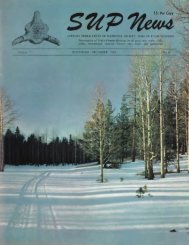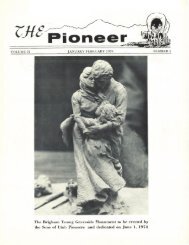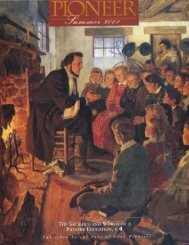Pioneer: 2011 Vol.58 No.3
Create successful ePaper yourself
Turn your PDF publications into a flip-book with our unique Google optimized e-Paper software.
One of the most contentious issues<br />
at the Constitutional convention<br />
revolved around slavery and how slaves<br />
should be counted in the census. It was<br />
determined that slaves should count as<br />
three-fifths of a person.The final tally of<br />
the 1790 census showed that 3,929,326<br />
people lived in the United States of whom<br />
almost 700,000 were slaves. The largest cities<br />
were New York City, which had 33,000 inhabitants;<br />
Philadelphia, with 28,000 residents; and<br />
Boston, with 18,000 residents.<br />
The United States Census of 1850 was the seventh<br />
census of the United States. It was conducted<br />
by the Bureau of the Census on June 1, 1850. The<br />
official count did not, however, begin in the Utah<br />
Territory until 1851. On March 28, 1851, Brigham<br />
Young, governor, Utah Territory, assigned the duty<br />
of conducting the official census to the territorial<br />
clerk, Thomas Bullock.<br />
Bullock was one of the original 1847 Utah pioneers.<br />
He was born in 1816 in Leek, Stafforshire,<br />
England. At the age of 14 he left school to become<br />
a clerk in a law office and later worked as an excise<br />
officer for the British government. In 1841 Bullock<br />
and his wife joined The Church of Jesus Christ<br />
of Latter-day Saints, moving in 1843 to Nauvoo,<br />
Illinois, where he was hired as a private clerk to<br />
Joseph Smith. In 1847, Bullock traveled with the<br />
initial Mormon pioneer company to the Salt Lake<br />
Valley. At the General Assembly of the State of<br />
Deseret, held on December 2, 1850, Bullock was<br />
chosen as clerk of the House of Representatives.<br />
Later Bullocks was appointed to serve as the first<br />
clerk of the Utah Territory.<br />
The directive to Bullock from Governor Young<br />
stated:<br />
“To Mr. Thomas Bullock<br />
“Sir.<br />
“Whereas by an act of Congress, creating the<br />
Territory of Utah, approved September 9, 1850, in<br />
the 4th section thereof, it is, among other things,<br />
directed that the Governor, previous to the first<br />
election, shall cause a census or enumeration of<br />
the ‘Inhabitants of the several Counties and districts<br />
of the Territory to be taken.’”<br />
The order empowered Bullock and “such Assistants,<br />
as you may see fit to employ in your said<br />
Thomas Bullock<br />
duty” a counting of all persons residing<br />
in the Utah Territory except for Indians.<br />
Bullock was told he could begin<br />
the census count on April 1, 1851, and<br />
return the results by July 4 to Governor<br />
Young.<br />
For his services, Bullock was to “receive<br />
such compensation, as the Territorial<br />
Legislature, at its first session may allow.” On<br />
March 28, 1851, Bullock took his oath as a census<br />
marshal. He solemnly swore that he would “make<br />
a true and exact enumeration of all the Inhabitants<br />
within the district assigned to me” and further<br />
pledged to “make due and correct returns thereof to<br />
the Governor, to the best of my skill and ability.”<br />
The 1850 census marked the first time when<br />
there was an attempt to collect information about<br />
every member of the household, including women,<br />
children, and slaves. Previous U.S. censuses had<br />
just collected the names of the heads of the family.<br />
A $35 fine was assessed to any member of a household<br />
who failed to furnish accurate information<br />
that was not “to the best of his knowledge.”<br />
Bullock was directed to take a census in the following<br />
counties: Great Salt Lake, Davis, Weber, Utah,<br />
San Pete, Iron, Tooele, and also in the Green River<br />
Precinct (present-day Eastern Utah).<br />
The census results were recorded in log books.<br />
Each log listed, as required by the 1850 census<br />
guidelines, a number representing the city and<br />
county where the head of the household resided;<br />
a dwelling number; the name of the head of the<br />
household, followed by household members,<br />
the individuals’ ages, genders, color; and occupation<br />
of family members, as well as the real worth<br />
of the property of the head of the household; the<br />
place of each household member’s birth; whether<br />
the person had been married within the year;<br />
whether they had attended school within the<br />
year; whether they were “a person over 20 who<br />
cannot read and write”; and whether they were<br />
“deaf, dumb, blind, insane, idiotic, pauper or<br />
convict.”<br />
As a result of the Indian Appropriation Act of<br />
1847, all Native Americans were to be counted in<br />
a special and separate 1850 census. In past censuses<br />
only Native Americans who paid taxes were<br />
counted. However, no mention is made of any<br />
<strong>Pioneer</strong> <strong>2011</strong> ■<br />
volume 58 ■<br />
number<br />
3 39<br />
www<br />
■<br />
sonsofutahpioneers<br />
■<br />
org







